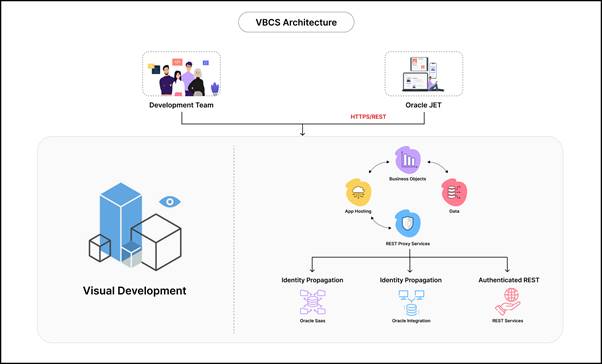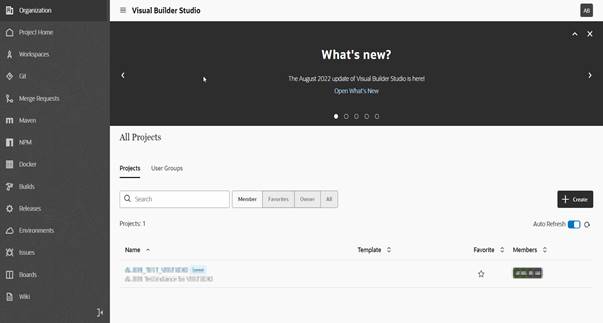Oracle provides several tools for application design and development. One of the most popularly used tools is Visual Builder Cloud Service. Using the Oracle VBCS tool, developers can build a seamless front-end application. It is important to note that tools like VBCS or ADF (Application Development Framework) work on the principles defined and managed using Oracle JET. Oracle JET is an open-source toolkit that acts as a guide for developers working on responsive front-end applications.
This blog will cover the basics of Oracle VBCS and how it is better than any other front-end application development tool. So, let’s begin.
Oracle Visual Builder Cloud Service
Visual Builder is an efficient tool to create and host all types of web and mobile apps with an added layer of Cloud security.
Successful implementation of VBCS can be the easiest way to cut down the IT backlog in an organization. As it is an inclusive platform offering hosting and development, businesses can leverage VBCS to its full potential.
In Visual Builder Cloud Service, it is possible to get direct access to data from REST-based service and use it to develop commonly used objects for efficient and secure data storage and management. The best part about working with VBCS is that there is no requirement to use another tool/software for hosting, creating, or testing the applications. Moreover, the drag-and-drop elements in VBCS allow the development team to reduce their turnaround time significantly.
Visual Builder Cloud Service Features
Cloud Hosted Solution
Due to evolving technological needs, there is a rise in demand for role-specific applications. In this case, businesses needed a solution surpassing this restriction and still managed to develop the latest applications without any major challenges.
The VBCS platform is a cloud-based platform that reduces the need for code and includes visual drag-and-drop elements for anyone to easily host, develop and publish applications. The security of a Cloud-based platform is unmatched, and VBCS has a clear advantage that is preferred by development teams around the world.
VBCS Makes It Easier To Develop Applications
VBCS is an intuitive tool that was designed to simplify application development and hosting. This is because Oracle manages to host the development and runtime platform in the Cloud for enhanced security and ease of access. Due to this, there is a reduced dependence on the installation and maintenance of additional software.
The drag-and-drop feature is a part of a user-intuitive design element that is based on Oracle JET. Understandably, the drag-and-drop feature eases the development process; the development team can also get access to their code. This helps when there are any frequent changes that need to be performed on the code.
In the last five years, there has been an increased focus on mobile responsive applications as the number of mobile phones has increased to six billion, according to Statista. Here, the VBCS supports the development of mobile responsive applications and advanced web applications. For PWAs, the users don’t need to download the app from the app store, which is easier to use.
Coming to the application lifecycle, VBCS manages the entire lifecycle, from development to go-live. Using this tool, developers can collaborate on the app development project. In a way, VBCS has enough automation features to strengthen the developers’ abilities for ease of development and delivery.
Software as a Service Integration
Oracle VBCS is an apt tool for users looking to make the most of Oracle SaaS applications. For businesses wanting to leverage Oracle SaaS applications, Oracle VBCS is the ideal tool. VBCS offers ease of access to data objects via an integrated service catalogue. Moreover, the security of the Cloud discussed in the earlier points is an added advantage.
Cutting-Edge Architecture
Using the VBCS platform, businesses can create applications on modern architecture. Like some other frameworks, Oracle also uses HTML5 and JavaScript to handle the design elements of the application. It is significantly easier to develop a mobile-responsive and secure web/mobile application using VBCS because of Oracle JET.
VBCS uses REST interfaces to access current data sources in the backend. VBCS has the option to parse Swagger-based definitions for REST interfaces for the current services. Additionally, it is possible to leverage Extensions. These can include but are not limited to design elements, the application’s usability, and data storage and handling. These catalogues are already built in the framework, which helps the development team to improve user experience and take it to the next level.
Visual Builder Tools
As we have discussed above, Oracle has a number of tools to host, develop and publish web and mobile applications. Here, we are going to list some of the commonly used tools.
- Data Management Tools – These tools are used extensively for data storage and handling.
- Publishing Tools – As the name suggests, these tools are used later in the lifecycle to publish the app.
- Security Tools – VBCS comes with a number of tools for cloud security, data security, and access.
- Collaboration Tools – These are the type of tools where the entire team can brainstorm and collectively work on a single project from development to testing and publishing.
How can you benefit from Oracle VBCS?
Now, let us check out some of the benefits of choosing the VBCS platform over any other framework.
- VBCS is not a server-side framework. This means the user is not always connected with the server, and the connection is established only when needed. This significantly helps in reducing network latency by reducing the number of server requests.
- As we have mentioned in the features of VBCS, the design elements in VBCS are easy to manage due to the drag-and-drop feature.
- Oracle JET uses HTML and CSS; hence, UI elements are easier to perform using VBCS.
- There is an auto refresh functionality in VBCS, which is called when values change, and hence it can often go unnoticed by the normal user.
- Single Page Application or SPA is a modernized approach that can retrieve different codes (HTML, CSS, etc.) with a single page load. By doing so, server requests are reduced, and user experience is enhanced.
- There is no need to make changes in the application to view changes in the logic. Viewing these changes live in the application with a simple browser refresh is possible.
- VBCS works for mobile applications and PWAs which is much better than using a framework like ADF, which only supports a browser-based app.
- A UI designer can develop the action event without writing complex code.
Final Thoughts
As we come to the final part of this blog, we are sure that you have got a basic understanding of the features and benefits of VBCS. Notably, Oracle Visual Builder Cloud Service has all the components needed for the front-end design and development of web and mobile applications. The tool is easier to use, manage and maintain due to its design elements handling. What do you think about the VBCS tool? Let us know in the comments below if you want us to write a comparison blog between the two tools.

































